
In fungi, a basidiocarp, basidiome, or basidioma (pl. basidiomata) is the sporocarp of a basidiomycete, the multicellular structure on which the spore-producing hymenium is borne. Basidiocarps are characteristic of the hymenomycetes; rusts and smuts do not produce such structures. As with other sporocarps, epigeous (above-ground) basidiocarps that are visible to the naked eye are commonly referred to as mushrooms, while hypogeous (underground) basidiocarps are usually called false truffles.

An agaric is a type of fungus fruiting body characterized by the presence of a pileus (cap) that is clearly differentiated from the stipe (stalk), with lamellae (gills) on the underside of the pileus. In the UK, agarics are called "mushrooms" or "toadstools". In North America they are typically called "gilled mushrooms". "Agaric" can also refer to a basidiomycete species characterized by an agaric-type fruiting body.

The pileus is the technical name for the cap, or cap-like part, of a basidiocarp or ascocarp that supports a spore-bearing surface, the hymenium. The hymenium (hymenophore) may consist of lamellae, tubes, or teeth, on the underside of the pileus. A pileus is characteristic of agarics, boletes, some polypores, tooth fungi, and some ascomycetes.

Amanita velosa, commonly known as the springtime amanita, or bittersweet orange ringless amanita is a species of agaric found in California, as well as southern Oregon and Baja California. Although a prized edible mushroom, it bears similarities to some deadly poisonous species.

Heliocybe is an agaric genus closely allied to Neolentinus and the bracket fungus, Gloeophyllum, all of which cause brown rot of wood. Heliocybe sulcata, the type and sole species, is characterized by thumb-sized, tough, revivable, often dried, mushroom fruitbodies, with a tanned symmetric pileus that is radially cracked into a cartoon sun-like pattern of arranged scales and ridges, distant serrated lamellae, and a scaly central stipe. Microscopically it differs from Neolentinus by the absence of clamp connections. Like Neolentinus, it produces abundant, conspicuous pleurocystidia. Heliocybe sulcata typically fruits on decorticated, sun-dried and cracked wood, such as fence posts and rails, vineyard trellises in Europe, branches in slash areas, and semi-arid areas such on sagebrush or on naio branches in rain shadow areas of Hawaii, or in open pine forests.

Crepidotus versutus, commonly known as the evasive agaric, is a species of fungus in the family Crepidotaceae. It is saprobic on wood, like other Crepidotus species, but it can also decompose herbaceous forest litter. The species is characterized by large, punctate, ellipsoid spores, and the white, hairy pileus.
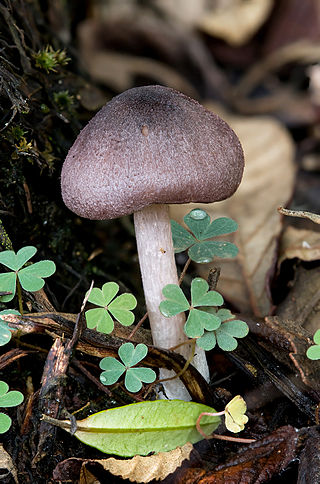
Entoloma austroprunicolor is a species of agaric fungus in the family Entolomataceae. Described as new to science in 2007, it is found in Tasmania, where it fruits on the ground of wet sclerophyll forests in late spring to early winter. The fruit bodies (mushrooms) have reddish-purple caps measuring up to 5 cm (2.0 in) in diameter supported by whitish stipes measuring 3–7.5 cm (1.2–3.0 in) long by 0.2–0.6 cm (0.1–0.2 in) thick. On the cap underside, the crowded gills are initially white before turning pink as the spores mature.

Marasmius rotula is a common species of agaric fungus in the family Marasmiaceae. Widespread in the Northern Hemisphere, it is commonly known variously as the pinwheel mushroom, the pinwheel marasmius, the little wheel, the collared parachute, or the horse hair fungus. The type species of the genus Marasmius, M. rotula was first described scientifically in 1772 by mycologist Giovanni Antonio Scopoli and assigned its current name in 1838 by Elias Fries.
Pluteus brunneidiscus is a species of agaric fungus in the family Pluteaceae. It was first described scientifically by American mycologist William Alphonso Murrill in 1917. It is found in Europe (Spain) and North America.

Amanita pekeoides is a species of fungus in the family Amanitaceae. It is endemic to New Zealand.
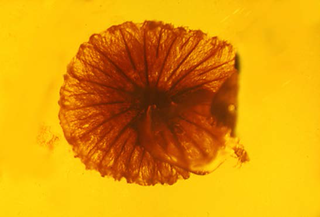
Coprinites is an extinct monotypic genus of gilled fungus in the Agaricales family Agaricaceae. At present it contains the single species Coprinites dominicana.
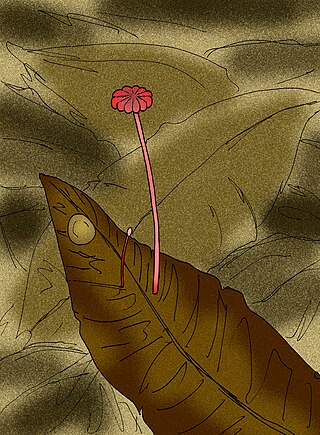
Archaeomarasmius is an extinct genus of gilled fungus in the Agaricales family Tricholomataceae, containing the single species Archaeomarasmius leggetti. It is known from two fruit bodies recovered from amber, one consisting of a complete cap with a broken stem, the other consisting of a fragment of a cap. The cap has a diameter ranging from 3.2 to 6 mm, while the stem is 0.5 mm (0.02 in) thick. Spores were also recovered from the amber, and are broadly ellipsoid to egg-shaped, measuring roughly 7.3 by 4.7 μm. The species, which resembles the extant genera Marasmius and Marasmiellus, is inferred to have been saprobic on plant litter or other forest debris.
Aureofungus is an extinct monotypic genus of gilled fungus in the order Agaricales. At present it contains the single species Aureofungus yaniguaensis.
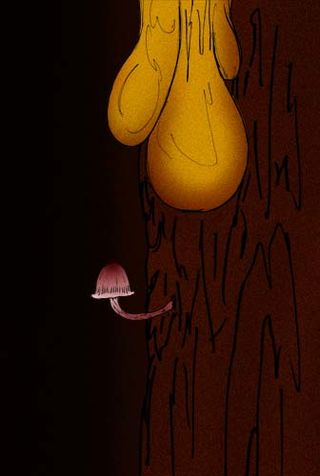
Protomycena is an extinct monotypic genus of gilled fungus in the family Mycenaceae, of order Agaricales. At present it contains the single species Protomycena electra, known from a single specimen collected in an amber mine in the Cordillera Septentrional area of the Dominican Republic. The fruit body of the fungus has a convex cap that is 5 mm (0.2 in) in diameter, with distantly spaced gills on the underside. The curved stipe is smooth and cylindrical, measuring 0.75 mm (0.030 in) thick by 10 mm (0.39 in) long, and lacks a ring. It resembles extant species of the genus Mycena. Protomycena is one of only five known agaric fungus species known in the fossil record and the second to be described from Dominican amber.
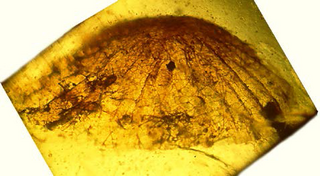
Palaeoagaracites is an extinct monotypic genus of gilled fungus in the order Agaricales. It contains the single species Palaeoagaracites antiquus.
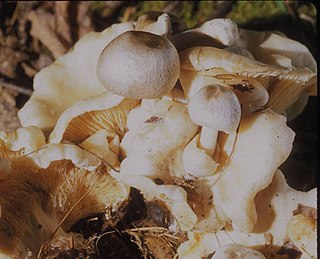
Volvariella surrecta, commonly known as the piggyback rosegill, is an agaric fungus in the family Pluteaceae. Although rare, the species is widely distributed, having been reported from Asia, North America, Northern Africa, Europe, and New Zealand. The fungus grows as a parasite on the fruit bodies of other gilled mushrooms, usually Clitocybe nebularis. V. surrecta mushrooms have white or greyish silky-hairy caps up to 8 cm (3.1 in) in diameter, and white gills that turns pink in maturity. The stipe, also white, is up to 9 cm (3.5 in) long, and has a sack-like volva at its base.

Filoboletus manipularis is a species of agaric fungus in the family Mycenaceae. Found in Australasia, Malaysia, and the Pacific islands, the mycelium and fruit bodies of the fungus grow in forests and can be bioluminescent. The fruiting bodies also display a variety of morphologies that have no current genetic attributions. References to Filoboletus manipularis can be found in Japanese folklore and Indonesian food culture.

Tricholoma vernaticum is an agaric fungus of the genus Tricholoma native to the Pacific Northwest region of the United States. The fungus was originally described in 1976 as a species of Armillaria when that genus was more inclusive; it received its current name twenty years later. The stout fruit bodies (mushrooms) have moist white to grayish caps, a membranous ring on the stipe, and an odor resembling cucumbers. Mycorrhizal with conifers, the fungus fruits in the spring or early summer, with its mushrooms appearing on the ground singly or in groups at high elevations, often at the edge of melting snowbanks. The edibility of the mushroom is unknown, but it has a strong unpleasant odor and a mealy taste.
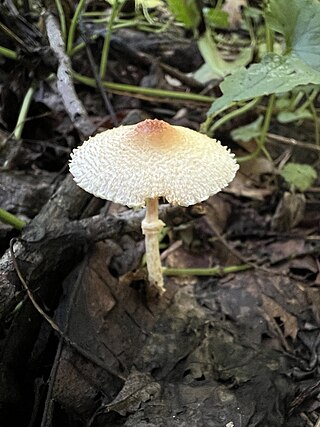
Lepiota maculans is a rare species of agaric fungus in the family Agaricaceae. It was originally collected in Missouri, and then 105 years later in eastern Tennessee. It is the only member of Lepiota known to have a pink spore print instead of the usual white or cream color. The fruit bodies have caps up to 4 cm (1.6 in) in diameter, with brownish, sparsely scaled centers. The gills are closely spaced, not attached to the stipe, and discolor reddish at the edges.

Pluteus microspermus is a saprotrophic, mushroom-like (agaricoid) fungi in the Section Pluteus. It is often confused with Pluteus concentricus, a species endemic to New Zealand because P. concentricus also has concentric ridges on its cap (pileus). P. microspermus and P. concentricus can be differentiated by microscopy as the spores are different sizes. P. concentricus also has rougher material on its stipe.

















